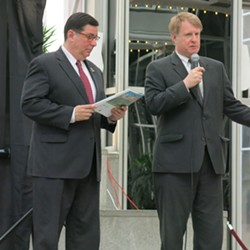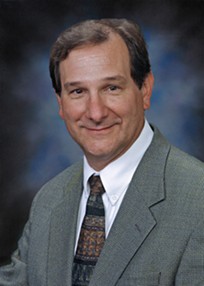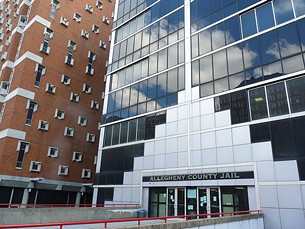Thursday, April 30, 2015

The GBA launched its district in 2012, with initial participation from property owners Downtown (including North Side stadium-and-parking district). Late last year, the district expanded to include Oakland.
On the path to 2030, the target for the end of 2015 is to reduce both energy and water use by 10 percent from baseline numbers. The report covered through 2014, by which time participants had cut total energy use by 6.3 percent, 2030 District Director Anna Siefken told a crowd of 200 yesterday at Downtown’s PPG Place Wintergarden. The water-use target, by contrast, met its 10 percent reduction goal a year early.
The bigger news, though, might have been how many more property-owners have joined the challenge: There are now 85, more than double the number in 2013, and the count of affected properties has quadrupled, to 436, representing about 65 million square feet of real estate.
The District’s “Property Partners” now include property-owners ranging from the governments of Allegheny County and the City of Pittsburgh to corporations (Alcoa, Highmark, BNY Mellon, PNC, UPMC and more), real-estate companies, universities, churches, small businesses, and institutions like the Carnegie Museums.
The District convenes meetings of participants and provides tools to help them figure out how to use less water and energy. Attendees at yesterday’s announcement included both County Executive Rich Fitzgerald and Pittsburgh Mayor Bill Peduto, who took the stage together to discuss how participating city- and county-owned buildings have fared. “This is something that we’re both very, very passionate about,” said Fitzgerald.
The rise gives Pittsburgh both the highest number of commited buildings and the most square footage of any of the 10 North American cities with 2030 Districts, Siefken said. And that affords the District more opportunities to save resources and improve indoor conditions for the people who live in, work in or otherwise utilize those buildings.
The GBA calculated the total energy saved by participants at 503 million kBTUs, or enough to power 5,562 homes. About 53 million gallons of water were conserved, or enough for 262 homes (or 1.3 million loads of laundry).
Certain individual buildings did much better than average: The massive, century-old City-County Building, for instance, cut its energy use by 47 percent against the baseline. The David L. Lawrence Convention Center, touted as a green building from its inception, cut energy use by 27 percent. Other structures didn't so do well: The county’s STD Clinic, in Oakland, actually used 46 percent more energy than when it joined the District. Though Fitzgerald acknowledge such “backsliding,” nobody at yesterday’s event explained why it happened.
Looking ahead, while it took participating property-owners two-and-a-half years to cut energy use 6.3 percent, Siefken says that the goal of 10 percent by this year’s end is in reach. “We’re feeling confident we’re going to make it,” she told City Paper.
One reason for that confidence is all the new participants. In fact, many Downtown participants have actually already met their energy-reduction goals for 2020. But while Siefken noted that Oakland’s preponderance of university and hospital buildings presents a set of challenges distinct from Downtown (half of which is office space), she said the newcomers have plenty of low-hanging fruit to pick.
Meanwhile, Siefken said, GBA will continue trying to recruit participants in the districts, where participation currently includes 68 percent of the total square footage in Downtown and Oakland.
Tags: Green Building Alliance , Pittsburgh 2030 District , energy conservation , water conservation , Image
Vermont Sen. Bernie Sanders is putting aside his Independent hat, and grabbing a blue one: He's running for president as a Democrat. It's the early days, and no events have been scheduled. We'd like to see the feisty Sanders mix it up at a Democratic primary debate though.
Stay tuned to City Paper for updates to the Magnetic Chart of 2016 Primary Awesomeness, as well as upcoming coverage of Election 2016.
Tags: 2016 Election , 2016 Primary , Senator Bernie Sanders , Image
Directed by Camila Centeno (daughter of exiled Venezuelan author Israel Centeno, who you can read about here), the video skillfully captures that unique brand of frustrated isolation one feels when surrounded by people who are having fun.
The Lampshades leave for tour next week, so be sure to catch them at one of the dates below (and/or alert your out-of-town friends.)
May 5, Velvet Lounge, Washington DC.
May 6, The Sidebar, Baltimore, MD.
May 7, North Star Bar, Philadelphia, PA.
May 8, Kilkenny's Ale House, Newark, NJ
May 9, Bowery Electric, NYC
June 20, The Shop, Pittsburgh.
Tags: The Lampshades , Restless , Numbskull Nothinghead , FFW>> , Video
Wednesday, April 29, 2015
"Our region continues to have some of the worst air pollution in the nation, especially from fine particulate matter," says Rachel Filippini, executive director of the Group Against Smog and Pollution. Fine particles, those up to 30 times smaller around than a human hair, penetrate deeply into the lungs. "We know fine particles are associated with many health problems, and are often associated with asthma and respiratory issues, but heart health is also a concern," she says.
The event is free and open to the public but is also targeted at medical professionals, who by attending can earn continuing medical-education credits through Allegheny Health Network, one of the sponsors of the event.
"They’re [medical professionals] often seen as a credible source of information, so having those professionals speak at public events and to decision-makers carries a lot of weight in pushing the message that clean air is critical," Filippini says.
Speakers will include Wayne Cascio, physician and director of the U.S. EPA's Environmental Public Health Division, and James Fabisiak, of the University of Pittsburgh's Graduate School of Public Health, who is one of the authors of the Pittsburgh Regional Environmental Threats Analysis.
"It’s possible that these small particles actually leave the lungs and travel in the bloodstream, but that’s probably the least likely scenario," says Cascio. "It's more likely that particles settle in the lungs where they initiate or cause inflammation and activate white blood cells, [which] release chemicals that travel and cause effects elsewhere in the body. The effects they provoke maybe actually be in the blood cells, liver [or] abdominal fat."
Cascio says those connections will be the main focus of the talk tomorrow night.
"The other possibility that is kind of intriguing is that the particles irritate receptors in the lungs, and the receptors then signal back to the brain. The brain then sends electrical signals back to the body, which influences blood and heart function," Cascio says. "Those effects are quite rapid, measured probably within minutes of being exposed to air pollution, whereas the others [scenarios] take longer."
He says his research at the EPA includes looking at population-level data and associations with air pollutants as well as animal and cellular studies to investigate the potential biological mechanisms to explain those associations. He says the EPA also does limited studies with volunteers who periodically have blood work and other biological evaluations to determine the effects of air-pollutant exposure in their daily activities.
"We thought it would be important to bring someone with expertise from the regulatory side as well as being a physician himself," Filippini says.
5-8 p.m. Allegheny General Hospital, Magovern Conference Center, 320 E. North Ave., North Side. More info at http://gasp-pgh.org/heart-health/
Tags: Pittsburgh , Air Quality , Group Against Smog and Pollution , Allegheny Health Network , Dr. Wayne Cascio , Rachel Filippini , Image

The story — about a clerk who quietly (and fearfully) defies the gigantic bureaucracy that employs him to go on a sort of latter-day knightly search for a mysterious (and anonymous) woman – is fairly slight. But Saramago’s vision, as faithfully translated to the stage by Quantum, is large enough to encompass questions about identity (how it’s formed, what it is), epistemology (what it means to “know” something) and more.
More than simply inhabiting an old building, the show is truly site-specific, with the decommissioned Carnegie Library of Allegheny standing in for the government hall where “all the names” are kept. And this original production, a collaborative creation of Quantum’s Karla Boos, Barbara Luderowski of the Mattress Factory and other artists, makes imaginative and expansive use of several rooms in this old North Side landmark (so be prepared for a little walking).
Here’s Tyler Plosia’s review for CP.
There are four more performances beginning with tonight’s.
Tickets are $38 and available here. Expect thematically appropriate snackies and a little drink at the intermezzo.
The former Carnegie Library of Allegheny is located on Allegheny Square on the North Side (part of the same complex as the New Hazlett Theater).
Tags: Quantum Theatre , All the Names , Carnegie Library of Allegheny , Program Notes , Image
Tags: FFW>>
Everyone's favorite heavy metal supergroup, Down, comes to Altar Bar on August 11 ($27-30, on sale Friday). Also at Altar Bar, Australian weirdos The Opiuo Band on June 6 ($15, on sale now); Hinder on July 11 ($21-23, on sale now); and the second installment of last week's Unity Concert featuring Joey Fatz, Scoot Hix, Shad Ali, Statement Records, John Basement, SOSA, DJ Nuke Nuke Knocka (of PR7X), Junior Maf and Hollyhood.
Trombone Shorty & Orleans Avenue will appear at Carnegie of Homestead Music Hall on September 16 ($39-60, on sale Saturday)
At the Smiling Moose: Elvis Depressedly is joined by Mitski, Eskimeaux, and the Incandescents on June 17 ($12, on sale tomorrow)
At Stage AE: X-Fest I headliners Rise Against, Letlive and Killswitch Engage were announced a few weeks ago: we now know that they'll be joined by Chevelle and Meg Myers. That's happening July 25 ($39.50-42, on sale now)
Tags: Concert announcements , FFW>>
Tuesday, April 28, 2015
The three-year agreement, reached late last week and disclosed by union officials today, covers 116 workers. It includes wage increases, advance notice of work shifts and more consistent assignments, according to United Steelworkers organizer Bernie Hall who worked with jail medical staff.
"It gives the employees a seat at the table," Hall says of the new contract. "These are the folks who are actively working with the patients in the jail — now they have some input on the direction of that care."
Teresa Latham, a nurse at the jail who was involved in negotiations, says there will be salary increases of anywhere from three to seven percent, schedules will be provided a month in advance and health-care workers will receive assignments that better relate to their experience and expertise. Neither Hall nor Corizon would immediately provide a copy of the contract.
"In the 14 years I've been there," Latham says, "we've never felt the need to organize or seek protections because conditions were nowhere near what they are now." She says ongoing problems with staffing levels and the availability of appropriate medications make it difficult to consistently provide basic care for inmates.
Asked to comment on the new contract, a Corizon spokesman wrote, "We are unable to disclose details at this time, but as soon as information is available we will provide it."
Allegheny County spokeswoman Amie Downs declined comment, saying the contract was between jail workers and Corizon.
Update (4/30/15): Late yesterday afternoon, Corizon released the following statement:
Corizon Health today announced it has reached an agreement with the union that represents medical staff at the Allegheny County Jail. The new three-year agreement, reached with United Steelworkers, includes a wage increase of 3 percent the first year of the contract and 7.5 percent over the life of the contract, new policies for scheduling and preferred medical assignments.
“We're pleased to finalize an agreement that is very fair for both sides,” said Susan Schranze, Chief Operating Officer, Northeast Region, Corizon Health. “Both parties negotiated together in good faith, made compromises, and produced a robust and responsive agreement. The agreement includes a wage increase, addresses requests by employees for primary assignments, and offers clear and equitable guidelines for planned time off. In addition, labor management meetings have already begun to ensure a positive working relationship with medical staff by establishing a formal mechanism to partner on issues. Corizon looks forward to building upon our relationship with our staff, who do outstanding work every day.”
Tags: Allegheny County Jail , ACJ , Corizon , USW , United Steelworkers , Teresa Latham , Bernie Hall , Image
The city is seeking public comment on "the purpose and need for transit improvements, as well as environmental issues that should be considered" and "possible station locations in Downtown, Uptown and Oakland for proposed [bus rapid transit] alignments." An overview of transit planning/projects in that corridor will also be presented, according to a press release.
Converting the Downtown-East End corridor to a bus rapid transit (BRT) system (in which buses typically get their own lanes, traffic signals and more prominent stations) would cost an estimated $200 million. And that plan has been somewhat controversial: Its proponents see it as a way of spurring development, while its detractors argue that after years of cuts, Port Authority should be paying more attention to restoring service than building fancier bus infrastructure along well-served routes. (For more context on the local debate about bus rapid transit, check out this primer).
The concept of transit-as-community-development-mechanism echoed in the city's announcement. The press release, for instance, includes language about an "EcoInnovation District" which refers to "a revitalized Uptown community, which is both environmentally and financially sustainable while promoting equity, and public and private sector innovation."
So if the intersection of local politics, community development and transit is your thing — these meetings might be worth a peek:
Noon–2 p.m. Tue., May 5. Duquesne University, Power Center Ballroom, 1015 Forbes Ave., Uptown
6-8 p.m. Wed., May 6. William Pitt Student Union, 3959 Fifth Ave., Oakland
Tags: bus rapid transit , BRT , Port Authority , city planning , EcoInnovation Distirct , transit , community development
Now the series has spun off into a book, and co-authors Chris Preksta and Curt Wootton are doing two appearances at local stores this week.
Tonight, find director Preksta and star Wootton (no doubt in wire-rims-wearing character) at the Barnes & Noble at the Waterfront at 7 p.m. for a book talk and signing. And on Saturday, the guys visit Sewickley’s Penguin Bookshop from 2-3 p.m.
Pittsburgh Dad: Everything Your Dad Has Said to You (Penguin Random House) is $14. Pittsburgh accent not included.
The B&N is at 100 West Bridge St., in Homestead. Penguin Bookshop is at 417 Beaver St.
Tags: Pittsburgh Dad , Chris Preksta , Curt Wootton , Barnes & Noble Waterfront , Penguin Bookshop , Image













